复旦大学国际贸易International Trade课件英文原版(1)
国际贸易英文PPT课件第1章

21.06.2021
华中科技大学经济学院 刘海云
14
2019年7月,ASEM会议的亚欧财长会议上,欧洲中央银行总裁德伊森 贝赫(Wim Duisenberg)和欧洲委员会主席普罗迪(Romano Prodi)也加 入了人民币升值论的合唱中。美欧官方的正式介入使得对人民币汇率 问题的争论进一步升温,《经济学家》、《华尔街日报》、《纽约时 报》、《金融时报》等西方主流媒体开始展开争执。国际货币基金组 织(IMF)、世界银行(WB)、以及国际清算银行(BIS)也纷纷发表意见。 包括蒙代尔(Robert Mundell)、克鲁格曼(Paul Krugman)、麦金农 (Ronald McKinnon)在内的一些著名经济学家,或以经济评论、或以专 业论文的形式展开讨论。
华中科技大学经济学院 刘海云
23
国际贸易的分类
按商品移动方向区分
出口贸易:是指把本国生产和加工的商品运往国外市场销售。 进口贸易:是指把外国生产和加工的商品输入国内市场销售。 复出口:是指外国商品输入国内,未经加工改制又再出口。 复进口:是指本国商品输往国外,未经加工改制又再进口。 过境贸易:甲国经过丙国向乙国出口商品,对丙国而言是过境贸易。
进出口统计的境界标 准
采用此标准的国家
国境
日本、英国、加拿大、澳 大利亚、中国、东欧等国
关境
德国、瑞士、意大利、 法国
21.06.2021
华中科技大学经济学院 刘海云
25
国际贸易的分类
按商品生产国和消费国之间有无第三国参与贸易区分
国际贸易的分类
按进出口统计的境界标准区分
总贸易(General Trade):是指以国境作为进出口统计标准的 贸易,凡进入国境的商品一律列为进口,离开国境的商品一律列 为出口。
international_trade讲义PPT教学课件
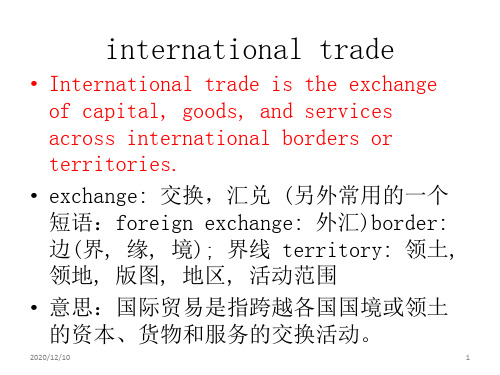
• Industrialization, advanced transportation, globalization, multinational corporations, and outsourcing are all having a major impact on the
2020/12/10
2
• While international trade has been present ['preznt] throughout much of history, its economic, social, and political importance has been on the rise in recent centuries.
international trade, nations would be limited to the goods and services produced within their own borders.
• source: 来源,根源 economic revenue: 经济 收入(revenue: 收入,收益,税收) world power: 世界强国 be limited to: 局限于,被 限制在…上
• 意思:国际贸易增长对全球化的持续发展
是至关重要的。
2020/12/10
5
• International trade is a major source of
economic revenue for any nation that is considered a world power. Without
• 意思:国际贸易是指跨越各国国境或领土 的资本、货物和服务的交换活动。
国际贸易International Trade
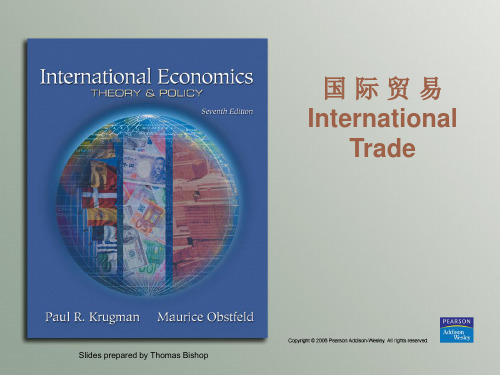
Table 1.1 U.S. Merchandise Trade by Industry, 2019, Shares of Total Trade and Production or Use (percentages)
Copyright © 2007 Pearson Addison-Wesley. All rights reserved.
activities at home.
docin/sundae_meng
docin/sundae_meng
Outsourcing on the value-chain
docin/sundae_meng
Another measurement: imported intermediate goods
63% of current GDP in 2019 • The third largest one in the world • Current Export is $969 billion and import is $ 792 billion. • So trade surplus is $177 billion in 2019.
4-9
Table 1.3 Percentage Distributiog Groups, 1985-2019
Copyright © 2007 Pearson Addison-Wesley. All rights reserved.
4-10
How to Explain Growing Trade?
1979.
docin/sundae_meng
China’s Trade
• China has increased its penetration into rich countries’ market.
国际贸易简介ppt课件
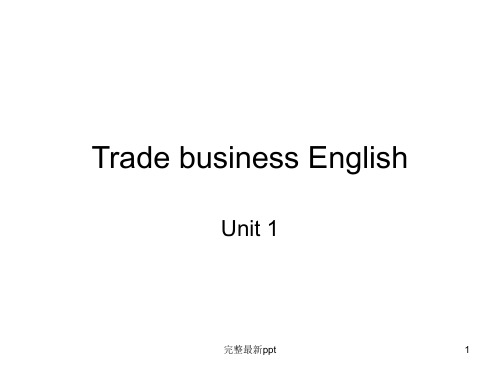
完整最新ppt
24
Lloyd 劳合船级社
• An famous institution in trade transportation.
• Leading:primary, dominants 主导的,主 要的
• Fee n.手续费,杂费 • Charge n.费用,收费
完整最新ppt
25
Behelux 比荷卢经济体
完整最新ppt
13
Economic benefit 经济利益
• Benefit (v.) from …从….中获利/获益 • Make profit from …从….中获利
– Benefit 利益,好处 – Interest 利益,利息
• At the cost of 以…的成本 • At the price of 以…的价格/代价
完整最新ppt
6
Trade operation 贸易操作
• business, operation,service 业务 • Operation 操作、运作、业务 • Trade operation: exportation and
importation
完整最新ppt
7
Resources
• Raw Material, geographical condition, population, traffic, technology, capital, etc
完整最新ppt
16
• Mass-produce 大批量生产
• domestic demand/domestic supply 国内需 求/供给
• Efficient demand/ Efficient supply 有效需 求/供给
第一章 Introduction to International Trade 《国际贸易实务》PPT课件
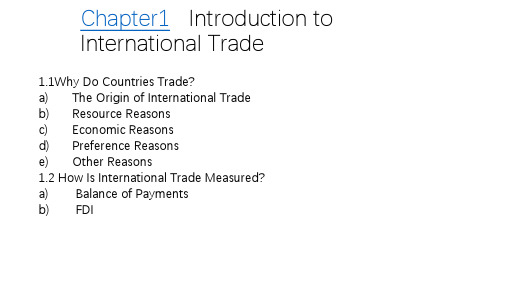
• Other nations depend on trade for a large part of their national income and to supply goods for domestic consumption.
FDI
Foreign Direct Investment (FDI) is the buying of permanent property and business in foreign nations. It can take the form of either direct or portfolio investment. Direct investment occurs when acquisition of equity interest in a foreign company is made. This interest may vary between a small percentage and a controlling interest of a company’s equity. (Ownership of more than 50% is not necessary in securing a controlling interest in a company). Controlling interest in a foreign company represents a high level of commitment to foreign operations and is usually accompanied by personnel and technology transfers abroad. The appeal of direct investment lies with the access to market and resources as well as rationalization of global production afforded by such an arrangement.
国际贸易英文课件 (1)

The Roots of Unethical
• Why do managers behave in a manner that is unethical?
– Business ethics are not divorced from personal ethics – Businesspeople sometimes do not realize they are
– Advocates of this approach argue that businesses need to recognize their noblesse oblige (benevolent behavior that is the responsibility of successful enterprises)
• In the international business setting, the most common ethical issues involve
– Employment practices – Human rights – Environmental regulations – Corruption – Moral obligation of multinational corporations
• Business ethics are the accepted principles of right or wrong governing the conduct of business people
国际贸易英文版教材
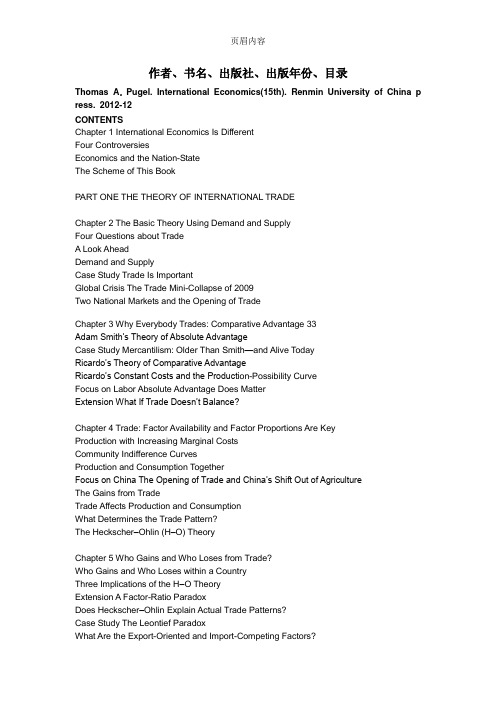
作者、书名、出版社、出版年份、目录Thomas A.Pugel. International Economics(15th). Renmin University of China p ress. 2012-12CONTENTSChapter 1 International Economics Is DifferentFour ControversiesEconomics and the Nation-StateThe Scheme of This BookPART ONE THE THEORY OF INTERNATIONAL TRADEChapter 2 The Basic Theory Using Demand and SupplyFour Questions about TradeA Look AheadDemand and SupplyCase Study Trade Is ImportantGlobal Crisis The Trade Mini-Collapse of 2009Two National Markets and the Opening of TradeChapter 3 Why Everybody Trades: Comparative Advantage 33Adam Smith’s Theory of Absolute AdvantageCase Study Mercantilism: Older Than Smith—and Alive TodayRicardo’s Theory of Comparative AdvantageRicardo’s Constant Costs and the Producti on-Possibility CurveFocus on Labor Absolute Advantage Does MatterExtension What If Trade Doesn’t Balance?Chapter 4 Trade: Factor Availability and Factor Proportions Are KeyProduction with Increasing Marginal CostsCommunity Indifference CurvesProduction and Consumption TogetherFocus on China The Opening of Trade and China’s Shift Out of AgricultureThe Gains from TradeTrade Affects Production and ConsumptionWhat Determines the Trade Pattern?The Heckscher–Ohlin (H–O) TheoryChapter 5 Who Gains and Who Loses from Trade?Who Gains and Who Loses within a CountryThree Implications of the H–O TheoryExtension A Factor-Ratio ParadoxDoes Heckscher–Ohlin Explain Actual Trade Patterns?Case Study The Leontief ParadoxWhat Are the Export-Oriented and Import-Competing Factors?Focus on China China’s Exports and ImportsDo Factor Prices Equalize Internationally?Focus on Labor U.S. Jobs and Foreign Trade 86Chapter 6 Scale Economies, Imperfect Competition, and TradeScale EconomiesIntra-Industry TradeMonopolistic Competition and TradeExtension The Individual Firm in MonopolisticOligopoly and TradeExtension The Gravity Model of TradeChapter 7 Growth and TradeBalanced versus Biased GrowthGrowth in Only One FactorChanges in the Country’s Willingness to TradeCase Study The Dutch Disease and DeindustrializationEffects on the Country’s Terms of TradeTechnology and TradeFocus on Labor Trade, Technology, and U.S. WagesPART TWO TRADE POLICYChapter 8 Analysis of a TariffGlobal Governance WTO and GATT: Tariff SuccessA Preview of ConclusionsThe Effect of a Tariff on Domestic ProducersThe Effect of a Tariff on Domestic ConsumersThe Tariff as Government RevenueThe Net National Loss from a TariffExtension The Effective Rate of ProtectionCase Study They Tax Exports, TooThe Terms-of-Trade Effect and a Nationally Optimal TariffChapter 9 Nontariff Barriers to ImportsTypes of Nontariff Barriers to ImportsThe Import QuotaGlobal Governance The WTO: Beyond TariffsGlobal Crisis Dodging ProtectionismExtension A Domestic Monopoly Prefers a QuotaVoluntary Export Restraints (VERs)Other Nontariff BarriersCase Study VERs: Two ExamplesCase Study Carrots Are Fruit, Snails Are Fish, and X-Men Are Not HumansHow Big Are the Costs of Protection?International Trade DisputesFocus on China China’s First Decade in the WTOChapter 10 Arguments for and against ProtectionThe Ideal World of First BestThe Realistic World of Second BestPromoting Domestic Production or EmploymentThe Infant Industry ArgumentFocus on Labor How Much Does It Cost to Protect a Job?The Dying Industry Argument and Adjustment AssistanceThe Developing Government (Public Revenue) ArgumentOther Arguments for Protection: Non=economic ObjectivesThe Politics of Protection The Basic Elements of the Political-Economic Analysis Case Study How Sweet It Is (or Isn’t)Chapter 11 Pushing ExportsDumpingReacting to Dumping: What Should a Dumpee Think?Actual Antidumping Policies: What Is Unfair?Case Study Antidumping in ActionProposals for ReformExport SubsidiesWTO Rules on SubsidiesShould the Importing Country Impose Countervailing Duties?Case Study Agriculture Is AmazingStrategic Export Subsidies Could Be GoodGlobal Governance Dogfight at the WTOChapter 12 Trade Blocs and Trade BlocksTypes of Economic BlocsIs Trade Discrimination Good or Bad?The Basic Theory of Trade Blocs: Trade Creation and Trade DiversionOther Possible Gains from a Trade BlocThe EU ExperienceCase Study Postwar Trade Integration in EuropeNorth America Becomes a BlocTrade Blocs among Developing CountriesTrade EmbargoesChapter 13 Trade and the EnvironmentIs Free Trade Anti-Environment?Is the WTO Anti-Environment?Global Governance Dolphins, Turtles, and the WTOThe Specificity Rule AgainA Preview of Policy PrescriptionsTrade and Domestic PollutionTrans-border PollutionGlobal Environmental ChallengesChapter 14 Trade Policies for Developing CountriesWhich Trade Policy for Developing Countries?Are the Long-Run Price Trends against Primary Producers?Case Study Special Challenges of TransitionInternational Cartels to Raise Primary-Product PricesImport-Substituting Industrialization (ISI)Exports of Manufactures to Industrial CountriesChapter 15 Multinationals and Migration: International Factor MovementsForeign Direct InvestmentMultinational EnterprisesFDI: History and Current PatternsWhy Do Multinational Enterprises Exist?Taxation of Mul tinational Enterprises’ProfitsCase Study CEMEX: A Model Multinational from an Unusual PlaceMNEs and International TradeShould the Home Country Restrict FDI Outflows?Should the Host Country Restrict FDI Inflows?Focus on China China as a Host CountryMigrationHow Migration Affects Labor MarketsShould the Sending Country Restrict Emigration?Should the Receiving Country Restrict Immigration?Case Study Are Immigrants a Fiscal Burden?APPENDIXESA The Web and the Library: International Numbers and Other InformationB Deriving Production-Possibility CurvesC Offer CurvesD The Nationally Optimal Tariff周瑞琪. International Trade Practice. University of International Business and Economics press. 2011.9CONTENTSChapter One General Introduction(第一章导论)1.1 Reasons for International Trade (国际间贸易的起因)1.2 Differences between International Trade and Domestic Trade (国际贸易与国内贸易的差异)1.3 Classification of International Trade(国际贸易的分类)1.4 Export and Import Procedures(进出口贸易的程序)1.5 Overview of This Book (本书的基本内容)Summary(总结)Key Terms(主要术语)Abbreviations(缩略语)Exercises(练习)Specimens(单证样本)Chapter Two International Trade Terms(第二章国际贸易术语)2.1 Three Sets of Rules (三种贸易术语的解释规则)2.2 Basics of Incoterms 2010 (2010年国际贸易术语解释通则基本概念)2.3 Application Issues(贸易术语在使用中应注意的问题)2.4 Determinants of Choice of Trade Terms (贸易术语选用的决定因素)Summary(总结)Key Terms(主要术语)Abbreviations(缩略语)Exercises(练习)Chapter Three Export Price(第三章出口商品的价格)3.1 Expression of Export Price(出口价格的表达)3.2 Pricing Considerations(影响定价的因素)3.3 Calculation of Price(价格的计算)3.4 Understanding the Price(价格的评估)3.5 Communication of Price(价格的沟通)Summary(总结)Key Terms(主要术语)Abbreviations(缩略语)Exercises(练习)Chapter Four Terms of Commodity(第四章商品条款)4.1 Name of Commodity (商品的名称)4.2 Specifying Quality(商品的品质)4.3 Measuring Quantity(商品的数量)4.4 Packing and Marking(商品的包装及标志)Summary(总结)Key Terms(主要术语)Abbreviations(缩略语)Exercises(练习)Chapter Five Cargo Transportation(第五章国际货物运输)5.1 Ocean Transportation (海洋运输)5.2 Other Modes of Transportation (其他运输方式)5.3 Transportation Documents(运输单据)5.4 Shipment Clause in the Sales Contract(销售合同中的装运条款)Summary(总结)Key Terms(主要术语)Abbreviations(缩略语)Exercises(练习)Specimens(单证样本)Chapter Six Cargo Transportation Insurance(第六章货物运输保险)6.1 Fundamental Principles of Cargo Insurance(货物保险的基本原则)6.2 Marine Risks and Losses(海上风险和损失)6.3 Coverage of Marine Cargo Insurance of CIC(我国海上货物保险范围)6.4 Coverage of Marine Cargo Insurance of ICC(协会货物保险范围)6.5 Other Types of Cargo Insurance(其他货物保险的种类)6.6 Procedures of Cargo Insurance(货物保险程序)6.7 Insurance Terms in the Sales Contract(销售合同中的保险条款)Summary(总结)Key Terms(主要术语)Abbreviations(缩略语)Exercises(练习)Specimens(单证样本)Chapter Seven International Payments(第七章国际货款支付)7.1 Issues in Concern(影响支付条件的因素)7.2 Paying Instruments(支付工具)7.3 Remittance(汇付)7.4 Collection(托收)7.5 Basics of Letter of Credit(信用证基础知识)7.6 Types of Documentary Credit(跟单信用证的种类)7.7 Letter of Guarantee(L/G)(保函)7.8 Export Financing(出口融资)7.9 Payment Problems(支付中出现的问题)Summary(总结)Key Terms(主要术语)Abbreviations(缩略语)Exercises(练习)Specimens(单证样本)Chapter Eight Export Documentation(第八章出口单证)8.1 Significance of Documentation(单证的重要性)8.2 Basic Requirements for Documentation(单证的基本要求)8.3 Prerequisites of Documentation(制单的依据)8.4 Export Documents(出口单证的种类)8.5 Clause Concerning Documents in the Sales Contract(销售合同中有关单证的条款)Summary(总结)Key Terms(主要术语)Abbreviations(缩略语)Exercises(练习)Specimens(单证样本)Chapter Nine Inspection, Claim, Force Majeure and Arbitration(第九章商检、索赔、不可抗力和仲裁)9.1 Commodity Inspection(商品检验)9.2 Disputes and Claims(争议和索赔)9.3 Force Majeure(不可抗力)9.4 Arbitration(仲裁)Summary(总结)Key Terms(主要术语)Abbreviations(缩略语)Exercises(练习)Key to Exercises(练习答案)Glossary(词汇表)Appendix 1INCOTERMS 2010 (FOB, CFR, CIF)(附录12010年国际贸易术语解释通则(FOB,CFR,CIF))Appendix 2CISG 1980 (Part II)(附录2联合国国际货物销售合同公约1980(第二部分)) References (参考书目)帅建林. International Trade Practice. University of International Business and Economics press. 2007.9CONTENTSPart 1 OverviewChapter 1 Introduction to International TradeChapter 2 International Trade PolicyChapter 3 Trade Bloc and Trade BlockChapter 4 WTO :A Navigation GuidePart 2 Terms of International TradeChapter 5 International Trade TermsChapter Terms of CommodityChapter International Cargo TransportChapter 8 Cargo InsuranceChapter 9 Terms of PriceChapter 10 International Payment and SettlementChapter 11 Claims, Force Majeure and ArbitrationPart 3 International Trade ProcedureChapter 12 Launching a Profitable TransactionChapter 13 Business Negotiation and Establishment of ContractChapter 14 Exporting ElementsChapter 15 Importing ElementsChapter 16 DocumentationPart 4 Trade FormsChapter 17 Agency, Distribution and ConsignmentChapter 18 TendersChapter 19 Counter TradeChapter 20 Futures TradingChapter 21 E-CommerceAppendix Glossary of International Trade Terms with English-Chinese InterpretationsBibliographyPaul R.Krugman & Maurice Obstfeld. International Economics:Theory andPolicy,8E. Tsinghua University press. 2011-11Contents前言第1章绪论第1部分国际贸易理论第2章世界贸易:概览第3章劳动生产率和比较优势:李嘉图模型第4章资源、比较优势和收入分配第5章标准贸易模型第6章规模经济、不完全竞争和国际贸易第7章国际要素流动第2部分国际贸易政策第8章贸易政策工具第9章贸易政策中的政治经济学第10章发展中国家的贸易政策第11章贸易政策中的争论数学附录第4章附录要素比例模型第5章附录贸易下的世界经济第6章附录垄断竞争模模型张素芳,International trade: theory and practice. University of International Business & Economics Press, Beijing, 2010contentsSection I. International Trade Theory and PolicyCHAPTER 1.INTRODUCTION TO INTERNATIONAL TRADE1.The Reasons for International Trade1.1. Resources reasons1.2. Economic reasons1.3. Other reasons2. The Differences between International Trade and Domestic Trade'.'2.1. More plex context2.2. More difficult and risky2.3. Higher skills required3.Basic Concepts Relating to International Trade3.1. Visible trade and invisible trade3.2. Favorable balance of trade and unfavorable balance oft rade3.3. General trade system and special trade system3.4. Volume of international trade and quantum of international trade3.5. Commodity position of international trade3.6. Geographical position of international trade3.7. Degree of dependence on foreign tradeCHAPTER 2.CLASSICAL TRADE THEORIES1.Mercantilism1.1. The development of mercantilist thought1.2. The mercantilist economic system1.3. Economic policies pursued by the mercantilists1.4. Discussions2.David Hume's Challenge to Mercantilism2.1. Assumptions of price-specie=flow mechanism2.2. The price-specie-flow mechanism3.Adam Smith's Theory of Absolute Advantage3.1. Assumptions of Adam Smith's theory of absolute advantage3.2. Challenge to Mercantilism3.3. Example4.David Ricardo's Theory of Comparative Advantage4.1. The concept of parative advantage4.2. Example4.3. Analysis of the theory of parative advantage by using modemtools. CHAPTER 3.NEOCLASSICAL TRADE THEORIES.1.Gains from Trade in Neoclassical Trade Theory1.1. Increasing opportunity costs on the PPF1.2. General equilibrium and gains in autarky1.3. General equilibrium and gains after the introduction of international trade ...2.Reciprocal Demand Theory2.1. A country's offer curve2.2. Trading equilibrium2.3. Measurement of terms of trade3.Factor Endowment Theory3.1. Factor intensity in production3.2. Factor endowments, factor prices, and parative advantage3.3. Assumptions of the factor proportions theory.,3.4. The Heckscher-Ohlin theorem.:3.5. An example to illustrate H-O theorem.3.6. The factor price equalization theorem:3.7. The Stolper-Samuelson theorem4.The Leontief Paradox——An Empirical Test of the Factor Proportions Theory 4.1. The Leontief paradox.-4.2. Suggested explanations for the Leontief Paradox and related theories CHAPTER 4.POST-HECKSHER-OHLIN THEORIES OF TRADE1.The Product Cycle Theory1.1. The imitation lag hypothesis1.2. The product cycle theory2.The Linder Theory2.1. Assumptions of the Linder theory2.2. Trade es in the overlapping ranges of products ophistication.:3.Intra-Industry Trade Theory3.1. Explanations of intra-industry trade3.2. Measurement of intra-industry tradeCHAPTER 5.IMPORT PROTECTION POLICY: TARIFFS1.Types of Import Tariffs1.1. In terms of the means of collection1.2. In terms of the different tariff rates applied1.3. In terms of special purposes for collection2.The Effects of Import Tariffs2.1. Concepts of consumer surplus and producer surplus2.2. The welfare effects of import tariffs3.Measurement of Import Tariffs3.1. The 'height' of import tariffs3.2. Nominal versus effective tariff ratesCHAPTER 6.IMPORT PROTECTION POLICY: NON-TARIFF BARRIERS''1.Forms of Non-tariff Barriers.1.1. Quantity control measures1.2. Price control measures1.3. Para-tariff measures1.4. Finance measures1.5. Anti-petitive measures.,.1.6. Miscellaneous measures2.Effects of Non-tariff Barriers2.1. The effects of an import quota2.2. The effects of a subsidy to an import-peting industryCHAPTER 7.EXPORT PROMOTION AND OTHER POLICIES1.Export Subsidy and Production Subsidy1.1. Export subsidy and its effects1.2. Production subsidy and its effects.2.Other Export Promotion Policies2.1. Devaluation of home currency.2.2. Commodity dumping2.3. Bonded warehouse2.4. Special trade zone2.5. Export promotion programs3.Export Restrictions and Import Promotion Policies3.1. Export restrictions policies3.2. Import promotion policies4.Trade Sanctions4.1. Introduction to trade sanctions4.2. Effectiveness of trade sanctionsCHAPTER 8.ARGUMENTS AGAINST FREE TRADE1.Traditional Arguments against Free Trade1.1. Infant industry argument.1.2. Terms of trade argument1.3. Balance of trade argument1.4. Tariff to reduce aggregate unemployment argument1.5. Fair petition argument1.6. National security argument2.New Protectionism2.1. Tariff to extract foreign monopoly profit2.2. Export subsidy in duopoly3.The Political Economy of Trade Policy3.1. Median voter model3.2. Collective action theory.3.3. Contribution in political campaignsCHAPTER 9.REGIONAL ECONOMIC INTEGRATIONof Regional Economic Integration1.1. Preferential tariff arrangement1.2. Free trade area1.3. Customs union1.4. Common market.1.5. Economic union2.The Static and Dynamic Effects of Regional Economic Integration2.1. Static effects of regional economic integration2.2. Dynamic effects of regional economic integration3.Economic Integration in Europe, North America and Asia3.1. Economic integration in Europe……………………………………Chapter 10 International Cargo Transportation InsuranceChapter 11 International Trade PaymentChapter 12 Inspection,Claim,Force Majeure and ArbitrationChapter 13 Trade Negotiation and Formation of the ContractChapter 14 Implementation of the Contract丹尼斯·R·阿普尔亚德 & 小艾尔弗雷德·J·菲尔德 & 史蒂文·L·科布.国际贸易.中国人民大学出版社. 2012-7第1章国际经济学的世界第一部分古典贸易理论第2章早期的国际贸易理论:由重商主义向大卫·李嘉图的古典贸易理论的演进第3章大卫·李嘉图的古典贸易理论和比较优势第4章对古典贸易模型的扩充及验证第二部分新贸易理论第5章新古典贸易理论——基本分析工具的介绍第6章新古典贸易理论中的贸易利得第7章贸易提供曲线和贸易条件第8章贸易的基础:要素禀赋理论和赫克歇尔俄林模型第9章要素禀赋理论的实证分析第三部分贸易理论的扩展第10章后赫克歇尔俄林贸易理论与产业内贸易第11章经济增长与国际贸易第12章国际要素流动第四部分贸易政策第13章贸易政策工具第14章贸易政策的影响第15章对干涉主义贸易政策的争论第16章经济的政治因素与美国的对外贸易政策第17章经济一体化第18章国际贸易与发展中国家参考文献当我被上帝造出来时,上帝问我想在人间当一个怎样的人,我不假思索的说,我要做一个伟大的世人皆知的人。
国际贸易完整版课件全套ppt教学教程

• 三、国际贸易的作用和特点 • (一)国际贸易的作用 • 调节各国市场的供求关系 • 促进生产要素的充分利用 • 提高生产技术水平,优化国内产业结构 • 增加财政收入,提高国民福利水平 • 加强各国经济联系,促进经济发展
• (二)重商主义的贸易政策 • 货币政策 • 对外贸易垄断政策 • 奖出限入政策 • 鼓励发展本国航运的政策 • 发展本国工业的政策
• 二、绝对利益理论
• 亚当·斯密(Adam Smith,1727~1790 年)是资产阶级经济学古典学派的主要 奠基人之一,也是国际分工——国际贸 易理论的创始者,是倡导自由贸易的带 头人。亚当·斯密代表作《国民财富的性 质和原因的研究》(简称《国富论》)
• Z =(X + M)/GDP×100%
• 出口依存度是指一国在一定时期内出口 总额与其国内生产总值之比,其公式为: Zx = X /GDP×100%
• 进口依存度也称市场开放度是指进口总 额与其国内生产总值之比,其公式为:
• Zm = M /GDP×100%
• (六)贸易条件
• 贸易条件(Terms of Trade)又称交换比价 或贸易比价,即出口价格与进口价格之间的比 率,就是说一个单位的出口商品可以换回多少 进口商品。它是用出口价格指数与进口价格指 数来计算的,其计算的公式为:
• 一、国际分工的形成和发展 • 萌芽 • 形成 • 发展 • 深化
• 二、影响国际分工发展的主要因素 • 自然条件是国际分工产生和发展的基础 • 社会生产力是国际分工形成和发展的决定性因
素 • 人口、生产规模和市场制约着国际分工的发展 • 跨国公司的发展是推动当代国际分工的重要力
国际贸易英语第一章讲义
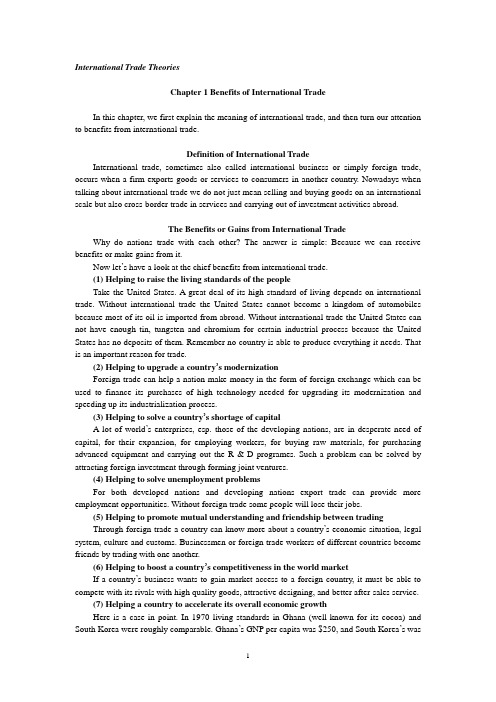
International Trade TheoriesChapter 1 Benefits of International TradeIn this chapter, we first explain the meaning of international trade, and then turn our attention to benefits from international trade.Definition of International TradeInternational trade, sometimes also called international business or simply foreign trade, occurs when a firm exports goods or services to consumers in another country. Nowadays when talking about international trade we do not just mean selling and buying goods on an international scale but also cross-border trade in services and carrying out of investment activities abroad.The Benefits or Gains from International TradeWhy do nations trade with each other? The answer is simple: Because we can receive benefits or make gains from it.Now let’s have a look at the chief benefits from international trade.(1) Helping to raise the living standards of the peopleTake the United States. A great deal of its high standard of living depends on international trade. Without international trade the United States cannot become a kingdom of automobiles because most of its oil is imported from abroad. Without international trade the United States can not have enough tin, tungsten and chromium for certain industrial process because the United States has no deposits of them. Remember no country is able to produce everything it needs. That is an important reason for trade.(2) Helping to upgrade a country’s modernizationForeign trade can help a nation make money in the form of foreign exchange which can be used to finance its purchases of high technology needed for upgrading its modernization and speeding up its industrialization process.(3) Helping to solve a country’s shortage of capitalA lot of world’s enterprises, esp. those of the developing nations, are in desperate need of capital, for their expansion, for employing workers, for buying raw materials, for purchasing advanced equipment and carrying out the R & D programes. Such a problem can be solved by attracting foreign investment through forming joint ventures.(4) Helping to solve unemployment problemsFor both developed nations and developing nations export trade can provide more employment opportunities. Without foreign trade some people will lose their jobs.(5) Helping to promote mutual understanding and friendship between tradingThrough foreign trade a country can know more about a country’s economic situation, legal system, culture and customs. Businessmen or foreign trade workers of different countries become friends by trading with one another.(6) Helping to boost a country’s competitiveness in the world marketIf a country’s business wants to gain market access to a foreign country, it must be able to compete with its rivals with high quality goods, attractive designing, and better after-sales service.(7) Helping a country to accelerate its overall economic growthHere is a case in point. In 1970 living standards in Ghana (well-known for its cocoa) and South Korea were roughly comparable. Ghana’s GNP per capita was $250, and South Korea’s was$260. By 1995, the situation had dramatically changed. South Korea had a GNP per capita of $ 9,700 while Ghana’s only $390, reflecting a vastly different economic growth rate. Between 1968 and 1995, the average annual growth rate in Ghana’s GNP was under 1.4%. In contrast, South Korea achieved a growth rate of about 9% annually in the same period of time. Why the sharp difference? Of course there is no easy answer because many factors affect a country’s growth. But one thing is certain, that is, The South Korean government implemented policies that encouraged companies to engage in international trade, while the actions of the Ghanaian government discouraged domestic producers from becoming involved in international trade. That is why some economists say foreign trade can be compared to the engine of economic growth.New Words1. cross-border 跨国境的2. tin 锡3. tungsten 铬4. chromium 钨5. deposit(s) 贮藏量6. to finance 为……提供资金7. to upgrade 使升级,提升8. vastly 巨大地9. industrialization 工业化10. firm 公司,企业11. modernization 现代化12. automobiles (美)汽车(常用auto)13. to boost 增加14. competitiveness 竞争力15. to accelerate 加快16. to implement 执行(政策等)Useful Phrases and Idiomatic Expressions1. on an international scale 在国际范围内2. a case in point 恰当的例子,例证3. to engage in 从事与4. to discourage sb. from doing sth. 不鼓励某人做某事,劝阻某人不做某事5. to be compared to 将……比作6. in the form of 以……形式,用……方式7. in contrast 相形之下8. to turn one’s attention to 将某人注意力转向ExercisesI. Answer the following questions:1. What is meant by international trade?2. What are the chief benefits from international trade?3. Give examples to show that no country is able to produce everything it needs.4. Does international trade have negative effects on a country’s economic development?II. Translate the following into English:1. 对外贸易可以给一国带来以下七个方面的好处:(1)通过对外贸易可以充分利用国外资源,协调发展它的国民经济;(2)通过与其他国家的贸易可以引进先进的技术设备,促进生产率的提高;(3)可以帮助它扩大资本的积累;(4)帮助一个国家进口国内无法生产的产品,更好满足国内人民的需求;(5)通过国际贸易可使一国参加国际分工;(6)通过国际贸易带动一国经济发展;(7)通过国际贸易发展对外经贸关系和扩大影响力。
应用国际贸易(中英文双语)PPT课件( 88页)
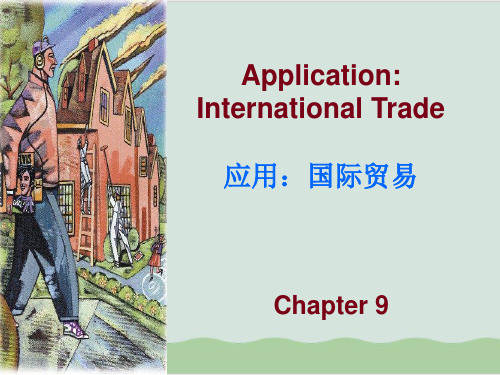
Price of Steel
Domestic supply
Price before trade
Price after trade
0
World Price
Imports
Domestic quantity demanded
Domestic quantity supplied
Domestic demand
A
B
C
Domestic supply
World price
Producer surplus before trade
Domestic demand
0
Quantity
of Steel
自由贸易如何影响出口国的福利
钢铁价格
贸易前的消费者剩余
贸易后的价格 贸易前的价格
A B
C
贸易前的生产者剩余
国内供给
世界价 格
国内需求
0
数量钢铁
How Free Trade Affects Welfare in an Exporting Country
Consumer Surplus Producer Surplus Total Surplus
Before Trade A+B C
A+B+C
After Trade A
B+C+D A+B+C+D
Quantity of Steel
图4. 进口国的国际贸易
钢铁 价格
国内供给
贸易前的价格 贸易后的价格
0
世界价格
进口
国内需求
国内供给量 国内需求量
钢铁数量
Figure 5 How Free Trade Affects Welfare in an Importing Country
国际贸易Chapter1IntroductiontoInternationalTrade.ppt
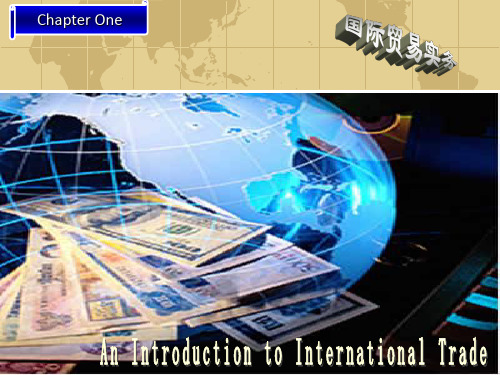
Visible Trade: Trade in goods which can be actually seen passing through ports or airport, entering or leaving one country.
Invisible trade: Trade in services and technologies
Major Categories of International Trade
Merchandise exports and imports (also referred to as visible trade). Service exports and imports (also referred to as invisible trade):tourism, transportation, performance of services and use of assets. Investments: foreign direct investment( FDI) and portfolio investment(间接投资,证券投资). Combination of visible & invisible trade:international processing trade, international leasing.
1.2. Why International Trade?
Numerous reasons for international trade:
- 1、下载文档前请自行甄别文档内容的完整性,平台不提供额外的编辑、内容补充、找答案等附加服务。
- 2、"仅部分预览"的文档,不可在线预览部分如存在完整性等问题,可反馈申请退款(可完整预览的文档不适用该条件!)。
- 3、如文档侵犯您的权益,请联系客服反馈,我们会尽快为您处理(人工客服工作时间:9:00-18:30)。
Slide 1-3
Introduction
Huge reductions in transport costs;
Steam power: rail, steamships; Suez Canal 1869; refrigeration.
Improvements in communications
Submarine telegraph cables linking financial markets: English Channel in 1851,
Copyright © 2003 Pearson Education, Inc.
Slide 1-7
Introduction
The study of international economics has never been
as important as it is now.
• At the beginning of the 21st century, nations are more
The Balance of Payments
• Some countries run large trade surpluses.
Slide 1-9
Introduction
Figure 1-2: Exports and Imports as Percentages of National Income in 1994
Copyright © 2003 Pearson Education, Inc.
Slide 1-10
What is International Economics About?
Copyright © 2003 Pearson Education, Inc.
Slide 1-8
Introduction
Figure 1-1: Exports and Imports as a Percentage of U.S. National Income
Copyright © 2003 Pearson Education, Inc.
Copyright © 2003 Pearson Education, Inc. Slide 1-13
What is International Economics About?
How Much Trade?
• Many governments are trying to shield certain industries
International economics deals with economic
interactions that occur between independent nations.
• The role of governments in regulating international trade
from international competition. • This has created the debate dealing with the costs and benefits of protection relative to free trade.
– Advanced countries’ policies engage in industrial targeting. – Developing countries’ policies promote industrialization:
Slide 1-12
What is International Economics About?
The Pattern of Trade (who sells what to whom?)
• Climate and resources determine the trade pattern of
– Bolshevik Revolution 1917 in Russia – Fascism in Italy 1920s, Nazism in Germany 1936, Franco victory in Spanish Civil War 1936
Great Depression in 1930’s; Collapse of world trade.
Repeal of the Corn Laws 1846: UK starts to import food in exchange for industrial goods; Global capitalism spread through conquest and colonialism;
Copyright © 2003 Pearson Education, Inc.
– U.S.: Smoot-Hawley Tariff Act 1930, which raised tariff of over 20,000 imported products
Copyright © 2003 Pearson Education, Inc.
Slide 1-5
Introduction
Capitalist model increasingly dominant:
– – – – Technological dominance of U.S; European integration; State-led industrialization failed to produce growth; Intellectual dominance of liberal economics .
closely linked through trade in goods and services, through flows of money, and through investment in each others’ economies than ever before. [Globally] • Figure 1-1 shows that international trade for the United States has roughly tripled in importance compared with the U.S. economy as a whole. [Locally]
and investment is substantial. • Analytically, international markets allow governments to discriminate against a subgroup of companies. • Governments also control the supply of currency.
Introduction
• Re-opening 1945- (Second Globalisation)
Three blocks until late 1980’s:
– 1/3 of world’s population – Socialist; – 1/2 of world’s population – State-led industrialization; – 1/6 of world’s population – Capitalist.
Chapter 1 Introduction
International Economics: Theory and Policy by Paul R. Krugman and Maurice Obstfeld
Chapter Organization
Introduction What is International Economics About? International Economics: Trade and Money
– Import substitution versus export promotion industrialization.
Copyright © 2003 Pearson Education, Inc.
Slide 1-14
What is International Economics About?
transatlantic 1866
Mass migrations: Europe to New World
Foreign direct investment
Enormous growth in trade helped by stable currencies: Gold Standard
Copyright © 2003 Pearson Education, Inc. Slide 1-4
Hawley and Smoot, the bogeymen of trade
A cautionary tale about how a protectionist measure opposed by all right-thinking people was passed.
Copyright © 2003 Pearson Education, Inc. Slide 1-6
several goods. • In manufacturing and services the pattern of trade is more subtle. • There are two types of trade:
– Interindustry trade depends on differences across countries. (Between Developed Countries and Developing ones) – Intraindustry trade depends on market size and occurs among similar countries. (Between Developed Countries)
